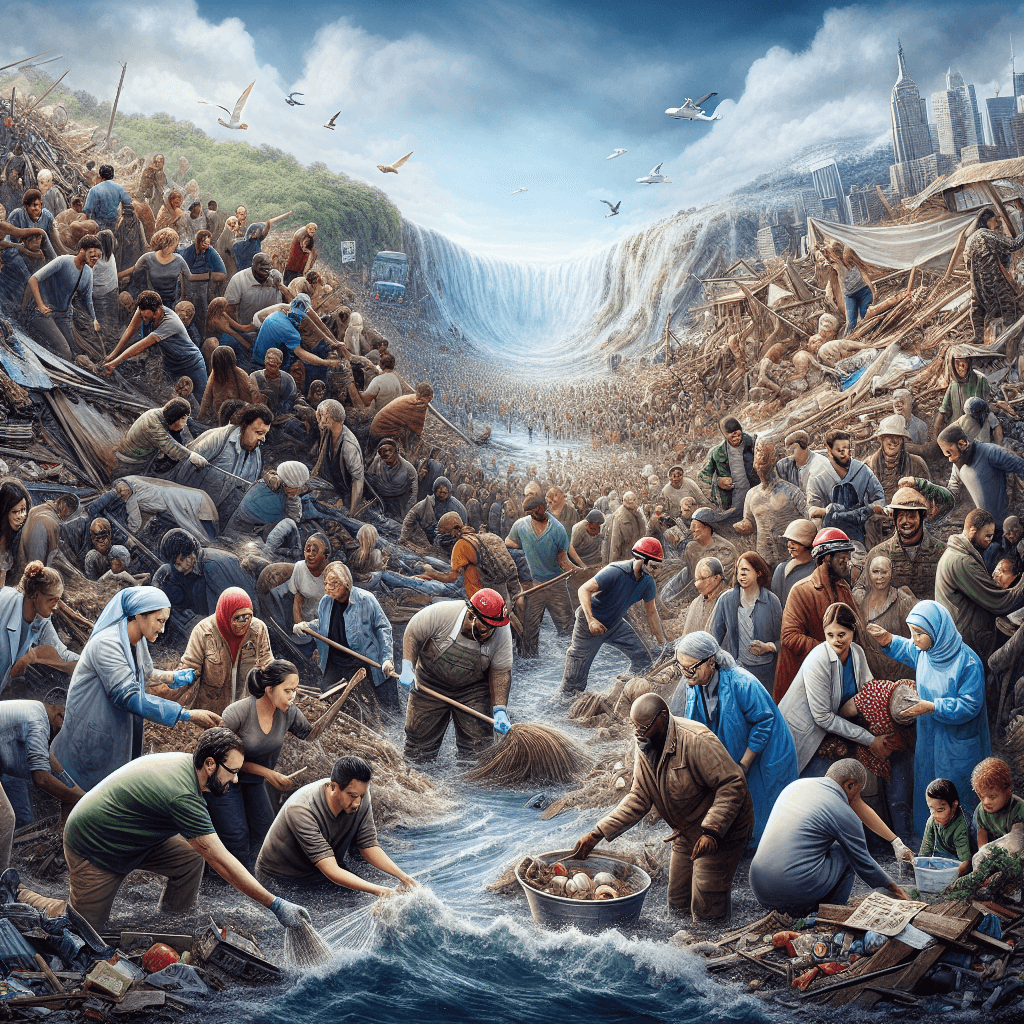In the midst of chaos and destruction, communities have a remarkable ability to come together and support one another in times of disaster. When faced with adversity, individuals band together, offering a helping hand, a shoulder to lean on, and resources to those in need. This incredible power of community is not only evident during the immediate aftermath of a disaster, but also plays a crucial role in long-term recovery efforts. By harnessing the collective strength and resilience of its members, communities are able to rebuild and restore, proving that unity and collaboration are key in overcoming even the most devastating of circumstances.
Table of Contents
Understanding the Importance of Community in Disaster Relief and Recovery
In times of disaster, the role of community support cannot be emphasized enough. Communities play a crucial part in both the immediate response to a disaster and the long-term recovery process. The sense of unity, cooperation, and resilience that comes from a strong community is instrumental in ensuring a successful and effective disaster relief effort.
Building resilience through community networks
One of the key benefits of community involvement in disaster relief is the ability to build resilience through community networks. When individuals come together to support one another, they form a web of interconnectedness that can provide invaluable assistance during times of crisis. By fostering these networks, communities can develop a robust infrastructure for disaster preparedness and response, enhancing their ability to withstand and recover from disasters.

Pre-Disaster Preparedness and Community Engagement
In order to effectively respond to a disaster, it is essential to involve the community in the planning and preparation process. promoting community involvement in disaster planning ensures that the unique needs and resources of each community are taken into account. By actively engaging community members in pre-disaster preparation, they become invested in their own safety and are more likely to take individual responsibility for preparedness measures.
Education and awareness programs are an integral part of community engagement in disaster preparedness. By providing information on potential hazards, evacuation routes, and emergency procedures, communities can ensure that residents are well-informed and equipped to respond appropriately in times of crisis. These programs not only empower individuals to protect themselves and their families but also foster a sense of collective responsibility and action.
Encouraging community members to take individual responsibility for disaster preparedness is another crucial aspect of community engagement. By emphasizing the importance of personal preparedness, communities can ensure that each individual has the necessary supplies, knowledge, and plans in place to effectively respond to a disaster. This proactive approach not only reduces the burden on emergency responders but also enhances the overall resilience of the community.
Community Mobilization in the Face of Disaster
The power of collective action cannot be understated in the context of disaster relief. When communities come together to respond to a crisis, they can pool their resources, skills, and knowledge to provide effective support to those in need. Establishing emergency response committees is a valuable way to mobilize community members and coordinate their efforts. These committees can provide a centralized platform for communication, decision-making, and resource allocation, ensuring a swift and efficient response.
Utilizing community resources and skills is another key aspect of community mobilization in disaster relief. Every community possesses unique assets and capabilities that can be harnessed during times of crisis. By identifying and utilizing these resources, communities can maximize their response capabilities and provide essential support to those affected by the disaster. This can range from leveraging local businesses for supplies and services to tapping into the expertise of community members in various fields, such as medical professionals or construction workers.

Effective Communication Channels in Community-Based Disaster Relief
Establishing reliable communication networks is paramount in community-based disaster relief efforts. Effective communication ensures that accurate and timely information reaches community members, enabling them to make informed decisions and take appropriate action. This can include disseminating information about evacuation orders, shelter locations, and available resources. By establishing reliable communication channels, communities can overcome barriers such as power outages or damaged infrastructure, ensuring that critical information reaches those in need.
Utilizing social media for information dissemination has become increasingly important in recent years. Platforms like Facebook, Twitter, and WhatsApp offer a fast and accessible way to reach a large audience and share information during a disaster. By leveraging these platforms, communities can quickly disseminate updates, provide safety instructions, and crowdsource information on available resources. However, it is important to ensure that the information shared is accurate and verified to prevent the spread of misinformation.
Building trust through transparent communication is also essential in community-based disaster relief. To effectively help communities recover, it is important to establish trust between disaster responders and community members. This can be achieved through open and honest communication, providing regular updates on relief efforts, and listening to the needs and concerns of the community. By fostering transparency, communities can feel confident in the support they receive and build long-lasting relationships with disaster responders.
Community-Led Rescue and Evacuation Efforts
During times of disaster, neighbor-to-neighbor support systems can be a lifeline for those in need. Communities that come together to help one another can provide immediate assistance to those impacted by a disaster, even before official response efforts are in place. This can include aiding in rescue operations, providing temporary shelter, and offering crucial supplies and support.
Creating evacuation plans within communities is a proactive measure that can save lives. By working together to identify safe evacuation routes, assembly points, and transportation options, communities can ensure a swift and orderly evacuation process. This collaborative approach not only enhances the safety and well-being of community members but also reduces the strain on official rescue and transportation resources.
Mobilizing community volunteers for rescue efforts is another powerful way in which communities can support one another during a disaster. By training and organizing community members to respond to emergencies, communities can enhance their capacity to save lives and provide immediate assistance. Volunteers can play various roles, such as conducting search and rescue operations, administering first aid, or providing emotional support to those affected by the disaster.

The Significance of Emotional and Psychological Support in Community Recovery
Disasters can have a profound impact on the emotional and psychological well-being of affected individuals. Establishing support groups within communities is crucial for addressing these needs and promoting healing and resilience. These groups provide a safe space for individuals to share their experiences, express their emotions, and receive support from others who have gone through similar circumstances. By connecting with others who have faced similar challenges, community members can find solace, strength, and the motivation to move forward.
Counseling and mental health services are essential components of community recovery efforts. Disasters can evoke feelings of fear, anxiety, grief, and trauma, which can have long-lasting effects if left unaddressed. By providing access to professional counseling services, communities can help individuals navigate their emotions, process their experiences, and develop coping strategies. This support is critical for rebuilding mental and emotional well-being, promoting resilience, and preventing long-term psychological consequences.
Promoting social cohesion and connectedness is vital for community recovery. Disasters often disrupt social structures and networks, leaving individuals feeling isolated and disconnected. By organizing community events, support groups, and activities aimed at bringing people together, communities can foster social cohesion and connectedness. These shared experiences help individuals rebuild a sense of community and belonging, offering a support system that goes beyond immediate disaster relief efforts.
Empowering Communities for Effective Recovery and Reconstruction
Community-led assessment and needs identification is an important step in effective recovery and reconstruction. By involving community members in the assessment process, their unique perspectives and experiences can be taken into account. This ensures that recovery efforts are tailored to the specific needs and priorities of the community, promoting self-determination and empowerment.
Collaboration with local organizations and authorities is essential for successful community-led reconstruction. By working together with local organizations, governments, and other stakeholders, communities can leverage their collective resources, knowledge, and expertise to drive sustainable recovery efforts. This collaboration enables communities to tap into external support while maintaining their autonomy and ensuring that their specific needs are met.
Providing resources and training for community-led reconstruction is crucial for empowering communities to take an active role in their own recovery. This can include providing financial assistance, technical expertise, and capacity-building programs to enhance the skills and abilities of community members. By equipping communities with the necessary tools and knowledge, they can actively contribute to the rebuilding and reconstruction process, ensuring a more resilient and sustainable outcome.

Lessons Learned from Community-Inclusive Disaster Management
community participation in disaster management has proven to be a sustainable approach that yields long-term benefits. By involving communities in all stages of disaster management, from preparedness to recovery, sustainable solutions can be developed that address the unique needs and challenges of each community. This approach ensures that communities are actively engaged in their own safety and well-being, resulting in more effective and resilient disaster response efforts.
Respecting cultural diversity and traditions is vital in community-inclusive disaster management. Each community has its own cultural values, practices, and beliefs that shape its identity and response to a disaster. By acknowledging and respecting these differences, disaster responders can ensure that relief and recovery efforts are culturally sensitive and appropriate. This approach builds trust and rapport with the community, enhancing the overall effectiveness of disaster management initiatives.
Enhancing disaster preparedness through shared experiences is an important outcome of community-inclusive disaster management. When communities come together to share their experiences, they create a collective knowledge base that can be used to improve future preparedness efforts. By reflecting on successes and challenges, communities can develop strategies, policies, and practices that better prepare them for future disasters. This continuous learning and improvement process strengthens community resilience and response capabilities.
The Role of Government and NGOs in Supporting Community Efforts
Collaboration and coordination with local agencies is essential for effective community disaster relief efforts. Government agencies have the resources, infrastructure, and expertise to support communities in times of crisis. By establishing strong partnerships with local agencies, communities can access vital resources, receive expert guidance, and benefit from coordinated relief efforts. This collaboration ensures a more comprehensive and holistic approach to disaster management.
Improving disaster response frameworks is an important role of government and NGOs in supporting community efforts. By continuously evaluating and updating response plans, policies, and procedures, governments and NGOs can ensure that communities receive the necessary support and resources during a disaster. This includes streamlining communication channels, enhancing coordination between various stakeholders, and establishing effective mechanisms for resource allocation.
Allocating resources for community-driven initiatives is a key responsibility of government and NGOs. By providing funding, supplies, and logistical support, these organizations can empower communities to take an active role in their own relief and recovery efforts. This support enables communities to leverage their strengths, resources, and knowledge to drive meaningful and sustainable change in the face of disaster.

Future Prospects and Challenges in Community-Based Disaster Relief
Harnessing technology for community engagement holds great potential for the future of disaster relief. Advancements in communication technologies, social media platforms, and data analytics offer new opportunities for communities to actively participate in disaster management. These technologies can facilitate real-time information sharing, resource coordination, and community mobilization, enhancing the overall effectiveness of community-based disaster relief efforts.
Addressing systemic inequalities in disaster management is a critical challenge that needs to be overcome. Vulnerable populations often bear the brunt of disasters, and their access to resources, information, and support can be limited. In order to ensure that community-based disaster relief efforts are inclusive and equitable, it is essential to address and mitigate systemic inequalities. This can be achieved through targeted outreach, tailored support, and resource allocation that takes into account the specific needs of marginalized communities.
Strengthening global networks for knowledge sharing is an important aspect of community-based disaster relief. By connecting communities around the world, knowledge and best practices can be shared, empowering communities to learn from one another and improve their disaster management capabilities. This global network facilitates cross-cultural collaboration, innovation, and mutual support, enabling communities to better prepare for and respond to disasters.
In conclusion, the power of community in disaster relief and recovery cannot be overstated. Communities play a vital role in all stages of disaster management, from preparedness to recovery and reconstruction. By actively engaging community members, mobilizing resources, fostering effective communication, and providing emotional and psychological support, communities can build resilience, save lives, and promote sustainable recovery. Collaboration between government agencies, NGOs, and community members is essential for effective community-based disaster relief efforts, and addressing challenges such as systemic inequalities and harnessing technology can further enhance these efforts. With a strong focus on community involvement, disaster management can become more inclusive, comprehensive, and empowering, ensuring a safer and more resilient future for all.

